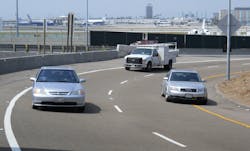High-friction surface treatment in L.A. reduces collisions
The I-105 Sepulveda Boulevard on-ramp is the primary egress point from Los Angeles International Airport. The two-lane ramp was notorious for collisions in wet pavement conditions. Collisions on the ramp have been attributed to a tight horizontal curvature, low friction and motorists’ aggressive driving. Accident records indicate that 80% of the collisions occurred when the ramp was wet.
In an effort to improve safety, the California Department of Transportation (Caltrans) implemented several improvements – significantly lowering the speed limit, posting curve-advisory signs and widening the shoulder of the outside lane. None of these achieved the desired results, according to Caltrans.
The desired safety results were achieved when Caltrans specified a flexible polymer resin binder and aggregate high-friction surface overlay system. Caltrans opted for a calcined bauxite aggregate, an extremely hard, polish and abrasion-resistant stone that when kept intact by the right binder can enhance the skid resistance and frictional characteristics of a road surface.
The overlay system, a product of Dow Poly-Carb, addressed three speed-related crash conditions: low friction, marginal friction (further reduced by weather) and friction values not compatible with approach speeds and geometrics. The overlay system is able to utilize a wide variety of aggregates, it may be applied to virtually any intact pavement surface and can help to address drainage concerns.
Safety results are the driving force for the use of the flexible polymer resin binder and aggregate high-friction surface overlay system, but application speed and knowledge are also important. Because it is a fast-curing system, the installation of the two lanes was completed overnight, and the ramp was open for rush hour the following morning.
According to Caltrans, there has been approximately a 41% reduction in crashes and no ramp closures due to rain during six months of available data following the overlay application. The performance metrics indicate why: pre-application skid factor on the ramp was 32; the post-application number is about 60.
